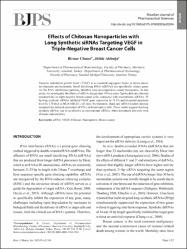| dc.contributor.author | Cömez, Birnur | |
| dc.contributor.author | Akbuğa, Jülide | |
| dc.date.accessioned | 2023-07-27T08:28:14Z | |
| dc.date.available | 2023-07-27T08:28:14Z | |
| dc.date.issued | 2023 | en_US |
| dc.identifier.citation | Cömez, B. ve Akbuğa, J. (2023). Effects of chitosan nanoparticles with long synthetic siRNAs targeting VEGF in triple-negative breast cancer cells. Brazilian Journal of Pharmaceutical Sciences, 59. https://dx.doi.org/10.1590/s2175-97902023e22304 | en_US |
| dc.identifier.issn | 1984-8250 | |
| dc.identifier.issn | 2175-9790 | |
| dc.identifier.uri | https://dx.doi.org/10.1590/s2175-97902023e22304 | |
| dc.identifier.uri | https://hdl.handle.net/20.500.12511/11266 | |
| dc.description.abstract | Vascular endothelial growth factor (VEGF) is an essential angiogenic factor in breast cancer development and metastasis. Small interfering RNAs (siRNAs) can specifically silence genes via the RNA interference pathway, therefore were investigated as cancer therapeutics. In this study, we investigated the effects of siRNAs longer than 30 base pairs (bp) loaded into chitosan nanoparticles in triple-negative breast cancer cells, compared with conventional siRNAs. 35 bp long synthetic siRNAs inhibited VEGF gene expression by 51.2% and increased apoptosis level by 1.75-fold in MDA-MB-231 cell lines. Furthermore, blank and siRNA-loaded chitosan nanoparticles induced expression of IFN-γ in breast cancer cells. These results suggest that long synthetic siRNAs can be as effective as conventional siRNAs, when introduced into cells with chitosan nanoparticles. | en_US |
| dc.description.sponsorship | Marmara University | en_US |
| dc.language.iso | eng | en_US |
| dc.publisher | Faculdade de Ciencias Farmaceuticas (Biblioteca) | en_US |
| dc.rights | info:eu-repo/semantics/openAccess | en_US |
| dc.rights | Attribution 4.0 International | * |
| dc.rights.uri | https://creativecommons.org/licenses/by/4.0/ | * |
| dc.subject | Breast Cancer | en_US |
| dc.subject | Chitosan | en_US |
| dc.subject | Nanoparticle | en_US |
| dc.subject | siRNA | en_US |
| dc.subject | VEGF | en_US |
| dc.title | Effects of chitosan nanoparticles with long synthetic siRNAs targeting VEGF in triple-negative breast cancer cells | en_US |
| dc.type | article | en_US |
| dc.relation.ispartof | Brazilian Journal of Pharmaceutical Sciences | en_US |
| dc.department | İstanbul Medipol Üniversitesi, Eczacılık Fakültesi, Eczacılık Teknolojisi Bölümü, Farmasötik Teknoloji Ana Bilim Dalı | en_US |
| dc.authorid | 0000-0002-1693-9579 | en_US |
| dc.identifier.volume | 59 | en_US |
| dc.relation.publicationcategory | Makale - Uluslararası Hakemli Dergi - Kurum Öğretim Elemanı | en_US |
| dc.identifier.doi | 10.1590/s2175-97902023e22304 | en_US |
| dc.institutionauthor | Akbuğa, Jülide | |
| dc.identifier.wosquality | Q4 | en_US |
| dc.identifier.wos | 001020586300001 | en_US |
| dc.identifier.scopus | 2-s2.0-85163849381 | en_US |
| dc.identifier.scopusquality | Q2 | en_US |



















